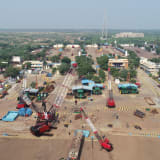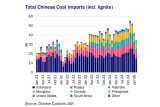
A rather monumental occurrence has taken place in the chemical industry, one which is poised to have significant impacts on trade flows and shipping. China, historically net short styrene and a significant importer, reported virtually zero imports of styrene in March. Why is this important, you ask? The impact is multi-faceted but, in short, this marks the culmination of a recent shift in production, particularly related to capacity growth in Asia.
Historically, China has accounted for roughly one-third of global styrene demand and has imported from regional partners as well as from the US and Middle East. However, the country is in the midst of a surge in domestic styrene production. Between 2022 and 2027, China is expected to see its capacity grow by as much as 9Mt.
During 2H 2023, about 1.2Mt of new SM capacities were slated to come online, per ICIS. Zhejiang Petroleum brought its new 600kt p.a. SM plant online while Anqing Petrochemical and Ningxia Baofe introduced new capacities of 400kt and 200kt p.a., respectively. Further growth is expected in 2024 with Chambroad Petrochemical expected to commence operations at a new 600kt p.a. plant while Shenghong Petrochemical is poised to start up a 450kt p.a. POSM unit in 2H 2024. This follows capacity additions exceeding 6.5Mt during the previous two years, according to Platts.
Short story long, capacity growth is negatively impacting import demand.
In the last three years, Chinese styrene imports have plummeted, with volumes falling below 40kt a month consistently throughout Q4 2023 and reaching zero in March 2024, according to Chinese Customs Statistics. The decrease in imports primarily affects Saudi Arabia, Japan and Korea, whose alternative markets are India or Europe.
One of the unintended consequences is that US producers now face increased competition for market share in Europe as the increase in volume pushes prices lower and increases pressure on high-costs producers. That pressure ultimately led to the shutdown of some capacities in 2022 and 2023.
In Europe, Trinseo shut its 500kt p.a. styrene and 730kt p.a. ethylbenzene plant at Terneuzen, Netherlands, in Q4 2023. This came following the closure of the company’s 300kt p.a. styrene plant at Boehlen, Germany, in Q4 2022 after earnings showed a $30 million loss over the period of four quarters. Asian producers have also been affect, with LG Chem shutting its 500kt p.a. styrene production at Daesan, Korea, in mid-2023.
The impact, however, is not confined to styrene. To better understand this, one must look at the impact on upstream markets. Styrene is produced using ethylene and benzene as feedstocks.
Historically, the US has imported Asian benzene and then exported styrene and derivatives, often sent back to Asia. This capacity growth, coupled with anti-duty duties against US, Korean and Taiwanese styrene a few years back, has all but halted US styrene exports to China.
This has resulted in Korean benzene producers, who historically have looked to the US, focusing their attention on China. According to information from the Chinese Customs Statistics office, average monthly benzene imports into China increased by more than 30kt/month between 2021 and 2023. In other words, China’s benzene imports were near 2.9Mt in 2021 versus roughly 3.26Mt in 2023. While there has been some capacity growth in the country, this is offset in part by new derivative plants for caprolactam, aniline, phenol and other chemicals. The expectation going forward is that China will remain one of the top benzene importers globally.

While the impact of all China’s styrene capacity growth is beginning to have an impact in different ways, the situation is not as dire as it may seem. New capacities will ultimately replace smaller, less efficient units. Poor economics have been responsible for a couple of shutdowns in China in Q1 of this year, with margin related outages at Ningxia Baofeng’s 200kt p.a. plant at Ningxia and Anhui Haoyuan at its 260kt p.a. facility at Anhui. Additionally, Jiangsu Lianyungang shut its 600kt p.a. styrene plant from December 2023 until late-April 2024 due to maintenance and poor economics.
Ultimately, less competitive plants will be forced to close, and the market will return to a more balanced state, with new downstream capacities also accounting for some volumes. Additionally, market length can be somewhat mitigated by reduced operating rates when margins are poor.
It is unlikely that China’s styrene imports volumes will remain at zero. There are too many factors at play, and China is expected to remain net short styrene for the near future. However, the report of zero styrene imports is significant as it highlights the impact of capacity growth in China and will impact the business strategies of European and US styrene makers and will alter global trade flows going forward.
By Kevin Allen, Chemicals Senior Analyst, Research, SSY
Articles
You may also be
interested in
View allGet in touch
Contact us today to find out how our expert team can support your business













